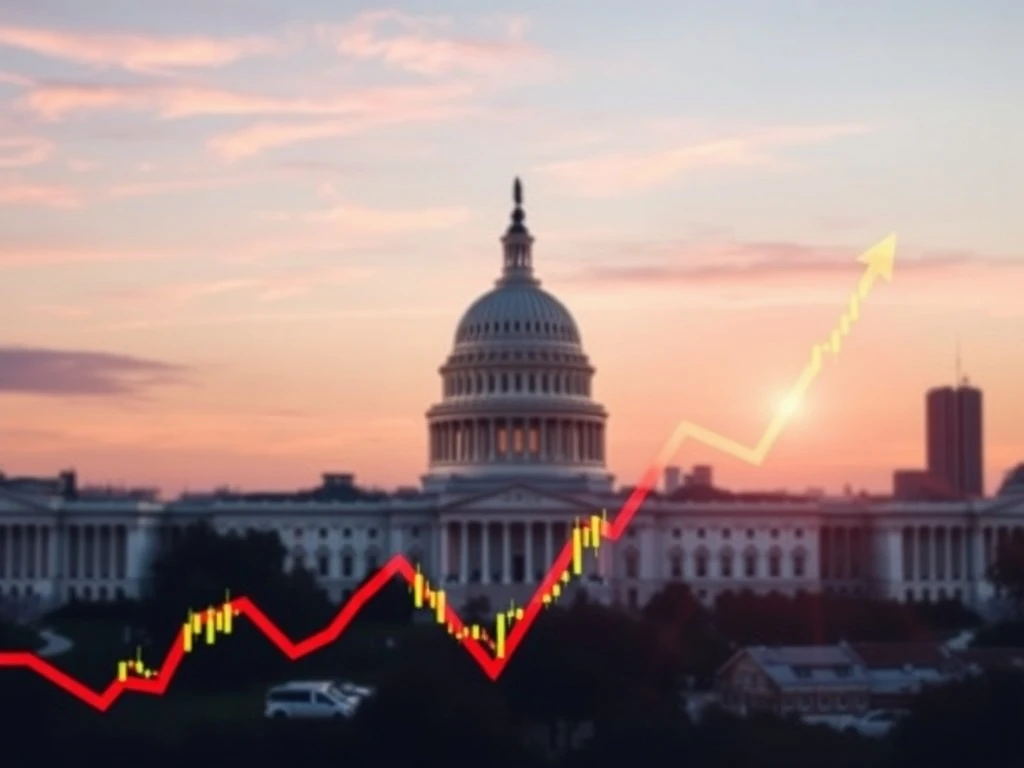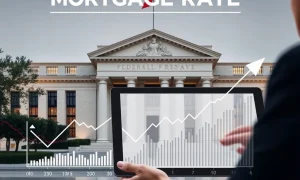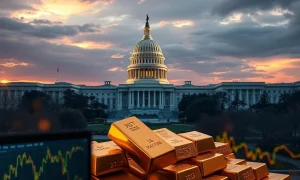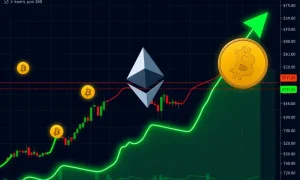Financial markets remain dynamic. Investors closely watch global cues. Currently, **stock futures** show modest gains. This signals cautious optimism across Wall Street. Traders are now keenly awaiting significant economic events. These events will shape future market trends. Understanding these shifts is crucial for any investor.
Understanding Current Stock Futures Movements
**Stock futures** represent agreements. They allow buying or selling a specific stock or index at a predetermined price on a future date. These contracts act as key indicators. They often predict the opening direction of the broader market. Recent modest increases in U.S. **stock futures** reflect a complex interplay of factors. These factors include geopolitical developments and anticipated central bank actions. For instance, positive corporate earnings reports can boost sentiment. Conversely, rising inflation concerns may dampen it. Market participants analyze these movements daily. They seek insights into potential shifts. Furthermore, futures trading provides a mechanism for hedging. It also allows for speculation on market direction.
What Drives Futures Markets?
Several forces influence **stock futures**. Firstly, economic data releases are paramount. Reports on inflation, employment, and consumer confidence directly impact investor outlook. Strong data often leads to higher futures. Secondly, corporate earnings announcements play a vital role. Positive results from major companies can lift entire sectors. This boosts overall market sentiment. Thirdly, geopolitical events create significant ripples. Trade disputes or international summits can introduce uncertainty or stability. This affects investor confidence. Finally, central bank policies are critical. Statements from the Federal Reserve, especially regarding interest rates, heavily sway futures markets.
The Geopolitical Landscape: Impact on Stock Futures
Geopolitical events consistently shape financial markets. Historically, major international summits or diplomatic shifts often lead to market reactions. These events introduce both opportunities and risks. For example, improved trade relations can open new market access. This boosts corporate profitability. Conversely, escalating tensions may trigger investor caution. They could prompt a flight to safety. The impact on **stock futures** is immediate. Traders adjust positions based on perceived stability or instability. Therefore, monitoring global political developments becomes essential for market participants. These developments directly influence market sentiment. They also affect investment strategies.
Analyzing Global Diplomatic Outcomes
Investors meticulously analyze outcomes from global diplomatic meetings. These gatherings often provide clarity on future policy directions. For instance, discussions on trade agreements or sanctions can signal significant economic shifts. A positive resolution typically fosters market confidence. This leads to an upward movement in **stock futures**. Conversely, a lack of consensus or new disputes can generate apprehension. Such situations may cause futures to decline. Consequently, market participants remain vigilant. They assess the implications of every diplomatic move. This helps them anticipate market responses. Ultimately, global stability often correlates with market growth.
Wall Street’s Focus: The Federal Reserve and Jackson Hole
Wall Street consistently pays close attention to the Federal Reserve. The Fed’s monetary policy decisions profoundly influence financial markets. Specifically, the annual Jackson Hole Economic Symposium is a highlight. This meeting brings together central bankers and economists globally. Here, key insights into future monetary policy often emerge. Investors eagerly await speeches from Fed officials. These speeches provide clues on interest rate paths and quantitative easing. Anticipation of dovish or hawkish stances directly impacts **stock futures**. A more accommodative Fed policy generally supports higher futures prices. Conversely, a tightening policy can exert downward pressure. Therefore, the Jackson Hole meeting serves as a critical barometer. It guides market expectations for the months ahead.
Anticipating Fed Policy Shifts
Market participants actively try to anticipate Fed policy shifts. They scrutinize every word from Fed Chair Jerome Powell. His statements at Jackson Hole often set the tone for monetary policy. For example, hints of rate hikes could signal a more challenging environment. This might lead to a sell-off in some **stock futures**. Conversely, indications of paused rate increases or potential cuts could spark a rally. This boosts investor optimism. The bond market also reacts significantly. Yields often move in anticipation of Fed actions. Ultimately, the Fed’s stance on inflation and employment drives market sentiment. This makes their communications incredibly impactful.
Key Economic Indicators Influencing Stock Futures
Beyond geopolitics and central bank policy, various economic indicators hold significant sway. These data points offer a snapshot of economic health. They provide crucial insights for investors. Understanding these indicators helps predict market movements.
- Inflation Data: Reports like the Consumer Price Index (CPI) directly affect monetary policy expectations. High inflation may prompt the Fed to raise rates. This can negatively impact **stock futures**.
- Employment Figures: Non-farm payrolls and unemployment rates reflect labor market strength. Strong employment often signals a healthy economy. This generally supports higher futures.
- Consumer Spending: Retail sales and consumer confidence surveys indicate household financial health. Robust spending fuels corporate revenues. This can drive futures higher.
- Manufacturing Data: The Purchasing Managers’ Index (PMI) shows manufacturing sector activity. A strong PMI suggests economic expansion. This typically supports positive market sentiment.
Each indicator contributes to the overall economic narrative. Investors analyze them collectively. They form a comprehensive view of market direction. This constant evaluation helps in making informed trading decisions. It ensures investors react appropriately to new information.
Navigating Volatility: Strategies for Investors
Financial markets are inherently volatile. **Stock futures** reflect this constant flux. Prudent investors adopt strategies to navigate these ups and downs. Firstly, **diversification** remains a cornerstone. Spreading investments across different asset classes reduces risk. This buffers portfolios against sector-specific downturns. Secondly, maintaining a **long-term perspective** is vital. Short-term fluctuations often obscure long-term growth trends. Focusing on fundamental value helps weather market storms. Thirdly, **staying informed** empowers decision-making. Regularly reviewing economic news and market analysis is crucial. This helps investors adapt to changing conditions. Finally, avoiding emotional decisions is paramount. Market reactions based on fear or greed often lead to suboptimal outcomes. A disciplined approach ensures better results. Investors should consult financial advisors for personalized guidance. This ensures alignment with individual financial goals.
The current landscape for **stock futures** reflects a delicate balance. Geopolitical events, central bank actions, and economic data all contribute to market sentiment. While modest gains signal cautious optimism, vigilance remains key. Wall Street’s focus on the Federal Reserve’s upcoming statements underscores the importance of monetary policy. Investors must continue to monitor these multifaceted influences. A well-informed and disciplined approach helps navigate the evolving market. Ultimately, understanding these drivers is essential for making strategic investment decisions in a dynamic global economy.
Frequently Asked Questions (FAQs)
What are stock futures?
Stock futures are financial contracts. They obligate a buyer or seller to transact a specific stock or index at a predetermined price on a future date. They allow investors to speculate on or hedge against future price movements.
How do geopolitical events affect stock futures?
Geopolitical events, such as trade agreements or international conflicts, can introduce uncertainty or stability into markets. Positive developments often boost investor confidence, leading to higher **stock futures**. Negative events can cause futures to decline.
Why is the Federal Reserve’s Jackson Hole meeting important for stock futures?
The Jackson Hole Economic Symposium is significant because Fed officials often use it to signal future monetary policy directions. Hints about interest rate changes or quantitative easing directly influence market expectations and, consequently, **stock futures** prices.
What economic indicators should investors watch for stock futures?
Investors should monitor key indicators like inflation data (e.g., CPI), employment figures (e.g., non-farm payrolls), consumer spending reports (e.g., retail sales), and manufacturing data (e.g., PMI). These provide insights into economic health and potential market movements.
How can investors navigate volatility in stock futures markets?
Investors can navigate volatility through diversification across asset classes, maintaining a long-term investment perspective, staying informed about market news, and making disciplined, rather than emotional, decisions. Consulting a financial advisor is also beneficial.
Are stock futures suitable for all investors?
**Stock futures** involve significant risk due to their leveraged nature and price volatility. They are generally more suitable for experienced investors with a higher risk tolerance and a thorough understanding of market dynamics. Novice investors should exercise caution and seek professional advice.








